A contemporary twist for Chinese New Year dishes
Issue: Jan 2023

Many dishes served at Chinese New Year celebrations have been passed down from generation to generation, each with its own special significance. Traditionally, a type of white wine called baiju - a spirit distilled from fermented sorghum, accompanies the festivities. However, in recent years wine has been emerging as a popular tipple amongst Singaporeans and enthusiasts are seeking imaginative ways to pair them with customary recipes for a modern take. Here are some of our favourite traditional dish-contemporary accompaniment pairings to bring in the new year!
The tradition: Yusheng
Yusheng is served at many celebratory events. This wonderfully colourful dish comprises raw fish (usually salmon) or abalone alongside shredded carrot, green and white shredded radish, pickled ginger, crushed peanuts, pomelo, cinnamon, pepper, and golden pillow crackers on a large circular plate, as well as a variety of condiments. Each ingredient has its own special significance, for example, the raw fish represents abundance, while plum sauce means stronger ties with loved ones as it brings the dish together, and as each one is assembled family and friends exchange blessings. Once prepared, there is a ritual called ‘lo hei’ where all those present stand up and toss the yusheng with their chopsticks, usually accompanied by enthusiastic cries of ‘huat ah!’, meaning prosperity. It is said that the person who throws the mixture the highest will have the most luck in the new year, so make sure to toss it as high as you can!
The wine pairing: Merlot
Merlot complements the spices, such as five spice powder blend, used in yusheng for an intriguing union of flavours.
The tradition: Whole fish
This emblematic dish is always served during Chinese New Year as it represents prosperity and wellness because the pronunciation of the word ‘fish’ also means ‘abundance’. Beautifully fragrant, the fish of choice is usually sea bass, and is steamed or fried whole with spices such as ginger, garlic, spring onion, and chilli. When ready for serving, a sizzling aromatic oil is theatrically poured over the dish.
The wine pairing: Sauvignon Blanc e.g. Sancerre or Pinot Noir
With this light dish, look for an elegant, minerally sauvignon blanc such as Sancerre that will not overpower the fish and elevates the flavour profile of the spices. If you’re more of a red wine fan, a light pinot noir will also work nicely.
The tradition: Dumplings
Dumplings are served at Chinese New Year because they look like old money bags or ‘Chinese Ingots’ and represent fortune and prosperity. These little pastry parcels are filled with a delectable mixture of ground meat, Napa cabbage, green onions, ginger, spring onions and soy sauce for a spectacularly savoury nibble. Some families pop a clean gold coin in one for a lucky guest to find - the recipient is said to make a lot of money in the new year!
Wine pairing: Grenache
Grenache is a rich wine bursting with juicy candied berries and sweet spices that will go hand in hand with dumplings, whatever kind you decide to serve.
The tradition: Pineapple tarts
A flaky, buttery, fruity end to the feast, pineapple tarts are called ‘wong lai’, which means ‘the arrival of prosperity’. Fresh pineapple is chopped up by hand and then made into a golden, sticky jam by combining it with cinnamon sticks, cloves and sugar. Meanwhile, the pastry is lightly flavoured with vanilla and filled with pineapple jam before being baked. These tart little mouthfuls of deliciousness are utterly moreish!
The wine pairing: Shiraz
A spicy Shiraz cuts through the rich tanginess and butteriness of these mouthwatering morsels, especially when it’s so hard to eat just one!
The tradition: Mandarins
No Chinese New Year is complete without gifting mandarins. The origin of offering mandarins hails from Southern China where they are known as ‘song gam’, which also means ‘giving gold’. It’s important to give them in even numbers as odd numbers are bad luck, while even numbers usher in good fortune. However, be sure to avoid the number four as this is a particularly unlucky number! Mandarins are sweeter and less acidic than regular oranges, and if you have many left they can be used in all sorts of baked goods or desserts.
The wine pairing: White Port
A Portuguese white port, lighter than its red counterparts, has light citrusy notes making it a perfect partner for mandarin orange desserts and pastry-based treats.
If you’re stocking up on wine ready for the festivities, contact Winebanc to see how we can help. Winebanc has private, exclusive, elegant wine cellars in various sizes, with 24/7 customer access across 3 locations conveniently located in the heart of Singapore. Visit us at www.winebanc.wine or contact us at 6955 9788 for more information!
From all of us here at Winebanc, we wish you prosperity, luck, and happiness in the Year of the Rabbit. Gong Xi Fa Cai!